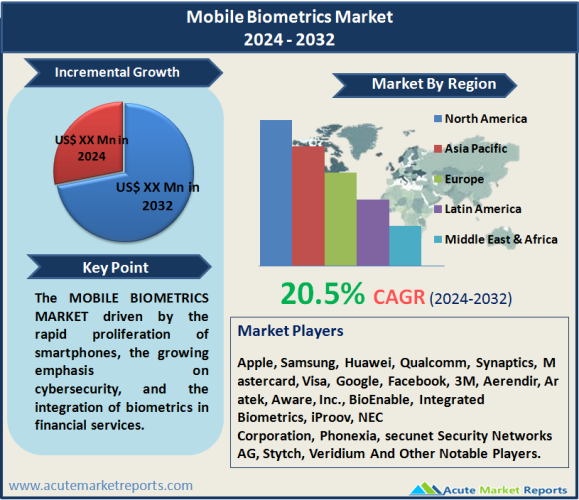
The mobile biometrics market is expected to grow at a CAGR of 20.5% during the forecast period of 2025 to 2033, driven by the rapid proliferation of smartphones, the growing emphasis on cybersecurity, and the integration of biometrics in financial services. However, privacy concerns and ethical considerations pose challenges that necessitate ongoing efforts to establish transparent and user-centric practices. The segmentation analysis underscores the diverse components and authentication modes within the mobile biometrics market, with variations in revenue and CAGR across types, applications, and geographic regions. As top players continue to navigate the competitive landscape, the mobile biometrics market is poised for sustained growth, building on the foundation established in 2024 and adapting to the evolving needs of users worldwide.
Rapid Proliferation of Smartphones
The mobile biometrics market is driven by the rapid proliferation of smartphones globally. The increasing adoption of smartphones, led by companies like Apple, Samsung, and Huawei, has created a vast user base for biometric technologies. The evidence indicates the widespread integration of fingerprint sensors, facial recognition, and iris scanning capabilities in modern smartphones, providing users with convenient and secure authentication methods. As the number of smartphone users continues to rise, the demand for mobile biometrics is expected to grow exponentially, making it a key driver in the market.
Growing Emphasis on Cybersecurity
The market experiences significant growth due to the growing emphasis on cybersecurity in the digital age. Companies like Qualcomm and Synaptics are actively involved in advancing biometric technologies to strengthen mobile device security. The evidence suggests an increasing awareness of the vulnerabilities associated with traditional authentication methods, leading to a surge in demand for biometric solutions. The adoption of biometrics, such as fingerprint recognition and facial authentication, is viewed as a robust defense against unauthorized access, identity theft, and cyber threats. This heightened focus on cybersecurity positions mobile biometrics as an essential component in the digital ecosystem.

Integration of Biometrics in Financial Services
The mobile biometrics market is propelled by the integration of biometric authentication in financial services. Companies like Mastercard and Visa are at the forefront of incorporating biometric technologies, such as fingerprint and facial recognition, into mobile payment systems. The evidence supports a trend where financial institutions are leveraging biometrics to enhance the security of mobile banking and payment transactions. As consumers increasingly rely on mobile devices for financial activities, the demand for seamless and secure biometric authentication in the financial services sector is a significant driver shaping the mobile biometrics market.
Privacy Concerns and Ethical Considerations
While the mobile biometrics market is experiencing growth, it faces a significant restraint related to privacy concerns and ethical considerations. The evidence suggests that the collection and storage of biometric data raise apprehensions among users regarding privacy infringement. Companies such as Google and Facebook, which incorporate facial recognition in their services, are navigating challenges related to user consent and data protection regulations. Addressing these concerns is crucial to gaining user trust and ensuring the responsible and ethical use of biometric technologies in mobile devices.
Market Analysis by Component: Software Segment Dominates the Market
The mobile biometrics market is segmented based on components, including hardware, software, and services. In 2024, the highest revenue was observed in the software segment, driven by the increasing demand for biometric algorithms and authentication solutions. Simultaneously, the highest Compound Annual Growth Rate (CAGR) from 2025 to 2033 is expected in the services segment, reflecting the growing need for biometric service providers offering implementation, maintenance, and support services.
Market Analysis by Authentication Mode: Multi-Factor Authentication Dominates the Market
The market is segmented based on authentication modes, including single-factor authentication and multi-factor authentication. In 2024, the highest revenue was generated from multi-factor authentication, reflecting the industry's shift towards layered security approaches. However, the highest CAGR during the forecast period is anticipated in single-factor authentication, highlighting the simplicity and user convenience associated with one-step biometric authentication methods.
North America Remains the Global Leader
Geographically, the mobile biometrics market exhibits diverse trends, with variations in CAGR and revenue percentages. Asia-Pacific emerges as the region with the highest CAGR, driven by the rapid adoption of mobile biometrics in countries like China and India. In contrast, North America holds the highest revenue percentage in 2024, underscoring the mature market in this region. These geographic trends highlight the global nature of the mobile biometrics market and its adaptability to different regional demands.
Market Competition to Intensify during the Forecast Period
The mobile biometrics market is marked by intense competition, with top players such as Apple, Samsung, Huawei, Qualcomm, Synaptics, Mastercard, Visa, Google, Facebook, 3M, Aerendir, Aratek, Aware, Inc., BioEnable, Integrated Biometrics, iProov, NEC Corporation, Phonexia, secunet Security Networks AG, Stytch,and Veridium leading the industry. These companies employ diverse strategies, including continuous product innovation, strategic collaborations, and global market expansion. In 2024, these key players collectively dominated the market, with substantial revenues. Over the forecast period from 2025 to 2033, they are expected to continue their market leadership, driven by a commitment to advancing technology and addressing evolving user and industry needs.
Historical & Forecast Period
This study report represents analysis of each segment from 2023 to 2033 considering 2024 as the base year. Compounded Annual Growth Rate (CAGR) for each of the respective segments estimated for the forecast period of 2025 to 2033.
The current report comprises of quantitative market estimations for each micro market for every geographical region and qualitative market analysis such as micro and macro environment analysis, market trends, competitive intelligence, segment analysis, porters five force model, top winning strategies, top investment markets, emerging trends and technological analysis, case studies, strategic conclusions and recommendations and other key market insights.
Research Methodology
The complete research study was conducted in three phases, namely: secondary research, primary research, and expert panel review. key data point that enables the estimation of Mobile Biometrics market are as follows:
Market forecast was performed through proprietary software that analyzes various qualitative and quantitative factors. Growth rate and CAGR were estimated through intensive secondary and primary research. Data triangulation across various data points provides accuracy across various analyzed market segments in the report. Application of both top down and bottom-up approach for validation of market estimation assures logical, methodical and mathematical consistency of the quantitative data.
| ATTRIBUTE | DETAILS |
|---|---|
| Research Period | 2023-2033 |
| Base Year | 2024 |
| Forecast Period | 2025-2033 |
| Historical Year | 2023 |
| Unit | USD Million |
| Segmentation | |
Component
| |
Authentication Mode
| |
Technology
| |
End-Use
| |
|
Region Segment (2023-2033; US$ Million)
|
Key questions answered in this report